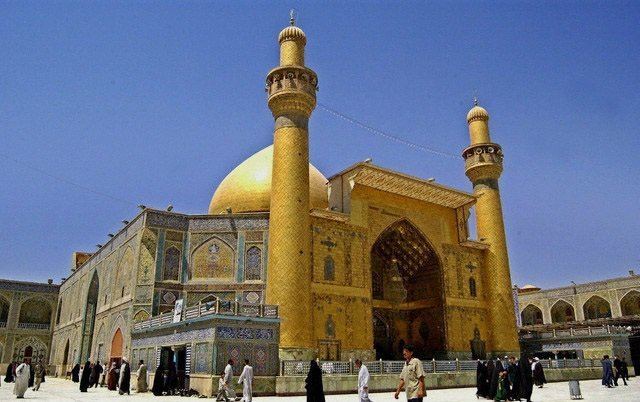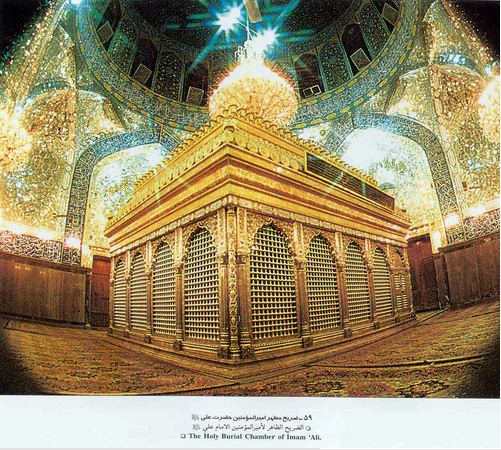Location Najaf, Iraq Completed 977 | Affiliation Shia Islam | |
 | ||
Burials Ali, Shia view of Ali, Mohammad Baqir al-Hakim Similar Imam Husayn Shrine, Al Abbas Mosque, Al‑Kadhimiya Mosque, Wadi‑us‑Salaam, Great Mosque of Kufa | ||
Imam ali mosque
The Imām 'Alī Holy Shrine (Arabic: حرم الإمام علي), also known as Masjid Ali or the Mosque of 'Alī, located in Najaf, Iraq, is the Holy site for Shia Muslims . 'Alī ibn Abī Tālib, the cousin of Muhammad, the first Imam (according to Shia belief) and fourth caliph (according to Sunni belief) is buried here. According to Shi'a belief, buried next to Ali within this mosque are the remains of Adam and Noah. Each year millions of pilgrims visit the Shrine and pay tribute to Imam Ali.
Contents

Imam ali mosque
History

The mosque was first built by the Buyid shahanshah 'Adud al-Dawla in 977 over the tomb of Ali. After being destroyed by fire, it was rebuilt by the Seljuk Malik Shah I in 1086, and rebuilt yet again by the Safavid Shah Ismail I shortly after 1500.

During the uprising of March 1991, following the Persian Gulf War, Saddam Hussein's Republican Guards damaged the shrine, where members of the Shia opposition were cornered, in storming the shrine and massacring virtually all its occupants. Afterwards the shrine was closed for two years, officially for repairs. Saddam Hussein also deported to Iran a large number of the residents of the area who were of Iranian descent.
Religious status
As the burial site of Shia Islam's second most important figure, the Imām 'Alī Mosque is considered by all Shias as the third holiest Islamic site The Boston Globe reports “for the world's nearly 320 million Muslim Shias, Najaf is the third holiest city, behind Mecca and Medina in Saudi Arabia. It is estimated that only Karbala, Mecca and Medina receive more Muslim pilgrims. A famous hadith mentions the site as one of "five definitive holy places that we respect very much".
Precincts
Also buried within this mosque according to Shias are Adam and Noah.

The site is visited annually by at least 8 million pilgrims on average, which is estimated to increase to 20 million in years to come. Many Shī'ah believe that 'Alī did not want his grave to be desecrated by his enemies and consequently asked his friends and family to bury him secretly. This secret gravesite is supposed to have been revealed later during the Abbasid caliphate by Ja'far as-Sādiq, the Sixth Shī'ah Imām. Most Shī'as accept that 'Alī is buried in Imām 'Alī Mosque, in what is now the city of Najaf (which grew around the shrine).

It has also been narrated from Ja'far as-Sādiq, the 6th Imām, that Imām 'Alī Mosque is the third of five holy places: Mecca, Medina, Imām 'Alī Mosque in Najaf, Imam Husayn Shrine in Karbalā, and the Shrine for Fātimah—daughter of Mūsā al-Kādhim in Qom.
Events in 2003–2006
Since the invasion of Iraq by the U.S. military in 2003, there have been a number of further attacks at the mosque:
